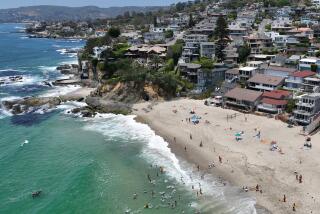Hazardous Duty : Lifeguards Take Cover With Sunscreens, Shirts and Shades
- Share via
ASK SANTA Monica State Beach lifeguard Jackie Burke about her skin-care routine and she starts spouting off SPF numbers. “A 40 on my lips, 30 on my face, 15 on my arms and chest and 6 on my legs,” says the blue-eyed blonde just before ripping off her regulation red jacket and white T-shirt and jumping into the Pacific for a save.
Protecting herself from the ravages of the sun is Burke’s biggest concern, so she takes extra care to apply sunscreen lotions with higher SPF levels where her skin is more sensitive. To combat the drying effects of the sun after exposure, she also moisturizes her face and conditions her hair daily.
Southern California lifeguards like Burke realize that spending eight hours on the beach every workday can make sun-induced skin cancer an occupational hazard. Many who used to wear deep-bronze tans like badges of honor can almost pass for pale office workers, even after an entire summer in the sun.
“Once the information about skin cancer and premature aging of the skin started coming out, lifeguards jumped right on it,” says a decidedly untanned Matt Karl, who has been a Huntington Beach lifeguard for the past nine years. Karl now wears a long-sleeved T-shirt every day, in addition to an SPF 30 sunscreen lotion, to protect his fair skin. “Once you hear about another guard getting cancer,” he says, “you think about it every day.”
Fifty-four-year-old Howard Lee, chief lifeguard of the Los Angeles County Department of Beaches and Harbor, has worked the beaches for 36 years. He had manned a guard tower for about 12 years when he developed skin cancer on his lip, and he recently had more cancerous cells removed from his shoulder. “Thirty years ago, we used baby oil to fry our skin,” remembers Lee, who also has no semblance of a tan today. “It’s not uncommon for (veteran) lifeguards to develop skin cancer. Now, because we have more knowledge, the guards check unusual skin conditions early, before they become cancerous.”
Although the county has no regulations about skin protection for lifeguards, Lee distributes advisory information at least twice each summer to notify his team of lifeguards about the latest developments in skin cancer research and sun protection. He also encourages the men and women to wear protective clothing such as hats and Windbreakers. But the decision to take these precautions is up to each individual, he explains. “When there’s a lot of rescue activity going on, it’s not always possible to keep a shirt and hat on.”
Mark Bitler, who has been a lifeguard at Will Rogers State Beach for 17 years, says that only the new lifeguards appear to feel invulnerable to the sun and still go after a tan. By contrast, he wears an SPF 15 sunscreen and a jacket most days and sees a dermatologist for checkups--just in case there might be early signs of the disease. “You start taking precautions as soon as your older co-workers start developing skin problems--or as soon as you see the first signs of aging on your own skin,” he says.
Since 1984, Christian Henry has spent six months of the year working as a Huntington Beach lifeguard. Bombarded by the media and his supervisors with information about the dangers of the sun, he’s become extra cautious. Now he wears a wide-brimmed hat and sunglasses with ultraviolet light protection, and he slathers on SPF 30. He also applies moisturizer to keep his skin supple. But despite his efforts, Henry’s skin is tanned, a sign that it hasn’t escaped unscathed.
What is an occupational hazard for lifeguards is, of course, a recreational hazard for the general public. So lifeguards also spend time trying to protect sunbathers, especially those who coat themselves with baby oil or low-SPF tanning products. For Henry, observing sunburned beach-goers is one of the job’s frustrations. “I see it happening every day, but by the time I warn them, it’s usually too late--they’re already fried.”
More to Read
Sign up for Essential California
The most important California stories and recommendations in your inbox every morning.
You may occasionally receive promotional content from the Los Angeles Times.










